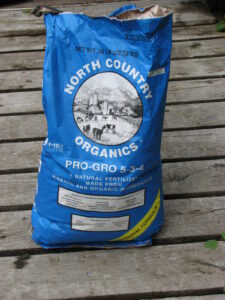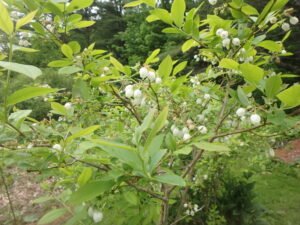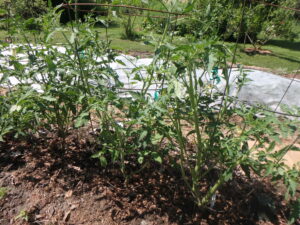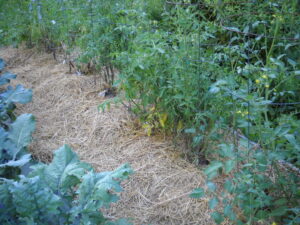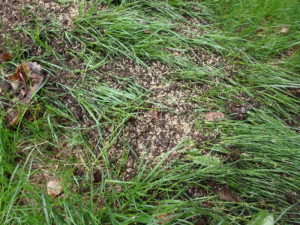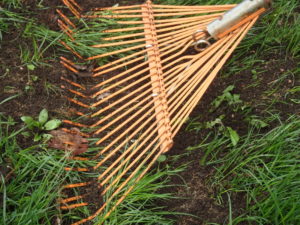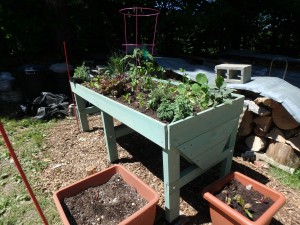How to Improve Your Soil
Bagged organic fertilizers are made from natural ingredients, things like ground oyster shells and seaweed, or dehydrated chicken manure, or cotton seed meal and peanut hulls. Added to the mix are minerals such as rock phosphate (a good source of slow-release phosphorus) and green sand (a source of potassium from the sea).
Here in the Northeast most soils are a bit acidic due to acid rain, so adding limestone is good for getting your soil near neutral. But not all plants need the same things in the soil. Blueberries, for example, need very acidic soil. Instead of lime, they may need sulfur to make the soil more acidic.
A simple soil pH test kit can be purchased for under $10, or you can send a sample to your state Extension Service for testing, Go online and search for soil tests in your state, and you will find how to collect the soil, and where to send it. A basic soil test will tell you much in addition to the soil pH.
I should explain that compost is not high in nitrogen. But most vegetables and annual flowers don’t need a lot of nitrogen. Nitrogen will make veggies like peppers or tomatoes grow big plants, but often those big plants do not produce a lot of fruit. Most annual flowers do not need much nitrogen.
Mulch all your beds with ground leaves, grass clippings, mulch hay or straw. These will break down with time, and add organic matter to the soil. Breakdown of that mulch is done by bacteria and fungi.
Spring Lawn Care
Lawns? My philosophy is this: If it’s green and you can mow it, it’s a lawn. Dandelions? Who cares? Their blossoms are cheerful. Creeping Charlie, plantain? Pests, but not awful. And so on. I love a lawn with some biodiversity. But bare and thin spots I like to fill in or over-seed. Now is the time to do that.
I recently called Paul Sachs of North Country Organics, manufacturer of Pro-Gro fertilizer and more, to talk about spring lawn care using organic products. Paul explained to me that all the New England states have laws against applying phosphate-containing fertilizer on lawns. Why? To minimize phosphate run-off into lakes, ponds and streams, thus reducing the growth of algae and other plants from running rampant and diminishing water quality.
Mr. Sachs explained that this law makes it technically illegal to fertilize your lawn – unless the middle number on your bag of fertilizer is “0”. Farmers who spread manure on the fields are exempt from this provision, and their fields are much more likely than you to cause run-off of phosphates.
There is a loop-hole to the law, however. Paul Sachs explained that you are allowed to fertilize with phosphate-containing fertilizers if you are also spreading seed. Most lawns have some thin spots, or bare spots, so adding seed makes sense. And if you use an organic fertilizer like Pro-Gro (a 5-3-4 fertilizer) there is very little soluble phosphate anyway. Its phosphorus content comes from rock phosphate, bone meal and bone char – all of which are only minimally soluble, and not normally a problem.
What is involved in over-seeding? Basically, you need to spread 3 to 5 pounds of seed per 1,000 square feet of lawn (roughly 30 feet by 33 feet). First, cut the lawn a bit shorter than you would otherwise. Then rake the lawn to remove the cut grass and any dead material that is on the lawn. You want seed to be in contract with the soil. If you have the time and energy, you can scuff up the soil in bare spots with a garden rake before spreading the seed. You can spread seed with a mechanical seeder, or, for small spots, just fling it using your hands.
I buy a small truckload of compost each year for use on my gardens and lawns. It is loose and fluffy and is easy to distribute. After spreading some seed, I fling compost with a shovel over the seed, and then smooth it out using a lawn rake turned upside down. My goal is to spread a quarter to a half an inch of compost on the lawn, at least in the areas that look the worst.
Compost is not necessarily rich in nitrogen – the driver of green growth – but it has organic matter, beneficial microorganisms and micro-nutrients that would not be found in a chemical fertilizer. If you are really interested in a deep green lawn with lush growth, you could not only spread compost, but also some organic fertilizer – Mr. Sachs recommends about 20 pounds of Pro-Gro per 1,000 square feet of lawn.
Almost any store that sells seed will have something called “Conservation Mix”. That is what I use. A typical mix might have 35 percent creeping red fescue, 25 percent turf type tall fescue, 10 percent Kentucky bluegrass, 12 percent turf type perennial ryegrass, 15 percent annual ryegrass, 3 percent white clover.
A few words about clover. When I was a kid back in the 1950’s, we sometimes spent lazy afternoons rolling around on the lawn and looking for 4-leaf clovers, said to guarantee good luck. But since then chemical companies have perfected “Weed-n-Feed” products that provide herbicides along with fertilizers to “ensure a perfect lawn.” Those products kill clover. So what have they done? They have declared clover a weed.
Clover is not a weed. It is a beneficial plant that actually takes nitrogen from the atmosphere and fixes it in the soil, essentially giving you free fertilizer. The seeds are tiny, so a little in a mix goes a long way. If you get an organic fertilizer it has no herbicides, so of course. And when you buy a bag of conservation mix, you may want to turn it upside down and shake it a little. Clover seeds tend to migrate toward the bottom of the bag, potentially giving an uneven distribution.
A conservation mix has the advantage of biodiversity. If a pest or disease attacks one grass, another might not be affected. Kentucky blue grass, for example, is lush and gorgeous, but susceptible to many diseases. A little is better than a lot in a mix.
Unless your lawn is right on the edge of a stream or lake, you probably will not be causing any problems by fertilizing your lawn a little. Lawn is a great filter, and will generally prevent the migration of fertilizer into water bodies. And there are organic fertilizers that have no phosphates at all: North Country Organics has a 6-0-6 called Natural No-Phos.
I know that some gardeners remove their lawns and put plants everywhere. But before you do that, remember that lawn is the easiest of all plantings to maintain. A little work now, some mowing as needed, and it looks good. Especially if, like me, you are not worried too much about the presence of a few dandelions.
Read Henry’s twice-weekly blog at https://dailyuv.com/
It’s Not Too Late to Start an Herb Garden
Garden centers are mostly sold out of flowers and vegetables by now, but there seem to be plenty of herbs still for sale. Now that you have (hopefully) gotten your veggies and annual flowers planted, this is a good time to plant some herbs.
My vegetable garden –where I have always grown herbs – is somewhat remote from my house and down a set of stone steps. But this summer I have an herb garden between my car park and wood pile – just 10 steps or so from the house.
So how do I grow parsley, sage, rosemary and thyme (and others not included in Simon and Garfunkel’s song) in a spot that sounds so inhospitable? I am growing them in a wooden container called a VegTrug that I got from Gardeners Supply (www.gardeners.com). It’s big and deep: six feet long, 2 feet wide and up to 18 inches deep in the middle of the V-shaped container. It is on legs and stands 30 inches high. Very nice, no bending over.
Filling up the VegTrug with appropriate planting mix is important: you can’t just dig garden dirt and shovel it in. The soil would compact and the plants wouldn’t thrive. But it takes over 400 quarts of soil mix to fill this behemoth. To buy that much potting mix would be pricey.
Getting the mix right is important: you want your mix to stay fluffy, hold water and offer nutrients. But if you just used a standard commercial potting mix, your growing medium would need weekly infusions of liquid chemical fertilizer. Adding compost introduces organic matter and beneficial microorganisms that work with the roots of your plants to share nutrients from the compost and organic potting soil.
I buy good quality compost each year that a local contractor makes from cow barn scrapings that he turns and aerates and makes into lovely light-weight compost that is relatively weed free. I mixed that compost with peat moss, “Moo-Grow” (an organic potting soil), organic fertilizer, limestone, perlite and vermiculite.
Vermiculite is a fluffy material made from heat-expanded mica that holds water. It is used in most potting mixes, though you might not notice it. I also added perlite, another heat-expanded mineral. It looks like Styrofoam, but is great for containers: it has a neutral pH, holds water and air, does not deteriorate or compress. I used a total of 6 quarts of each in my VegTrug. Perlite and vermiculite go a long way.
To make my soil mix I used a 5-gallon pail to measure, adding roughly 2 parts of compost and 2 parts of Moo-Gro potting mix to one part of peat moss. I stirred up that mix in a huge garden cart. I added half a cup of limestone per bucket of peat moss to counteract the acidity.
Once the ingredients were mixed, I add Pro-Gro, an organic bagged fertilizer. I used a total of 2 quart containers of Pro-Gro in the 100-plus gallons of soil mix I made. I added one quart of Azomite, a source of diverse mineral micronutrients, in the total mix. Azomite is optional. You could add rock dust instead, if you can get some very fine rock powder from a tombstone maker or a rock quarry. Or you can leave it out altogether.
It is important to get the ingredients well moistened before adding them to the VegTrug. I did this by adding water from my hose to the mix, and stirring with a shovel. Dry peat moss can be very hard to moisten; I wet it, stirred it, let it sit, and repeated until it seemed evenly moist.
So what am I growing? In the middle, where the soil is deepest, I have a tomato plant, one I started from seed called ‘Summer Sunrise’. The seeds came from the Hudson Valley Seed Library (www.seeedlibrary.org and is suited for container growing.
What else? I have about a dozen lettuce plants, 3 flat-leafed parsley plants, 2 kinds of sage, a rosemary and a thyme plant. I dug up a chunk of chives from my garden, cut it back and planted it in the VegTrug. Marjoram and a nasturtium are doing well – the latter has edible flowers, and will flow out and over from the VegTrug.
I planted dill and arugula by seed – both are up and doing fine, though I also bought a small pot of dill at my local Food Coop – another good source for pots of herbs. Lastly I planted a 4-pack of small basil plants. Everything is thriving!
Watering is important for containers. This VegTrug has shallow soil near the edges, deeper soil towards the middle, so the edges dry out quicker. I find I need to give it 4 to 6 gallons in hot, sunny weather. It only gets sunshine from 9am to 3pm, but that seems adequate.
So whether you invest in a VegTrug from Gardeners Supply or just grow some herbs in pots on the porch, go plant some. I am so delighted with my herb garden I know I will plant it again every year. And the collection of herbs in this nice cedar container is pleasing to the eye as well as the taste buds!
Read Henry’s blogs at https://dailyuv.com/



